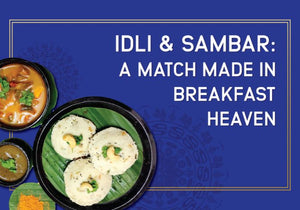Idli and Sambar: A Match Made in Breakfast Heaven

Feb 23, 2024
Introduction:
In the vibrant tapestry of Indian cuisine, few culinary duos evoke as much comfort and satisfaction as idli and sambar. These two iconic dishes, hailing from the southern regions of India, have captured the hearts and taste buds of millions, becoming synonymous with wholesome, flavorful breakfasts. Join us as we delve into the delightful world of idli and sambar, exploring their origins, preparation, and the unique bond that makes them an indispensable part of Indian culinary culture.
Origins and Tradition:
Idli, a soft, steamed rice cake, and sambar, a fragrant lentil stew, have deep roots in South Indian culinary traditions. Originating from the southern states of Tamil Nadu, Karnataka, and Andhra Pradesh, these dishes have been enjoyed for centuries, cherished for their simplicity, nourishment, and exquisite flavors. Traditionally served on banana leaves, idli and sambar symbolize the warmth and hospitality of South Indian households, where breakfast is more than just a meal—it's a celebration of family, community, and tradition.
Preparation and Ingredients:
The magic of idli lies in its preparation—made from a batter of soaked and ground rice and lentils, fermented overnight to achieve its characteristic lightness and texture. Similarly, sambar is a flavorful concoction of pigeon peas (toor dal), tamarind, and a medley of vegetables, simmered with aromatic spices like mustard seeds, curry leaves, and asafoetida. Together, idli and sambar create a harmonious balance of flavors and textures, with the softness of the idli complementing the tangy, savory notes of the sambar.
Culinary Delight:
The combination of idli and sambar is a culinary delight that transcends regional boundaries, captivating food enthusiasts across India and beyond. Whether enjoyed for breakfast, lunch, or dinner, this dynamic duo offers a symphony of flavors and a wholesome dining experience. In addition to its delicious taste, idli and sambar are also prized for their nutritional benefits, being low in fat, rich in protein, and packed with essential vitamins and minerals.
The Modern Twist:
While idli and sambar remain deeply rooted in tradition, they have also evolved to suit modern tastes and lifestyles. From innovative variations like mini idlis and quick sambar recipes to gluten-free and vegan-friendly options, these dishes continue to adapt and thrive in today's culinary landscape. Whether enjoyed at home, in restaurants, or at street food stalls, idli and sambar continue to bring people together, fostering a sense of connection and shared appreciation for good food.
Conclusion:
In a world filled with culinary delights, idli and sambar stand out as timeless classics that embody the essence of Indian cuisine—flavorful, wholesome, and deeply satisfying. As we celebrate the rich tradition and enduring appeal of these beloved dishes, let us savor each bite and cherish the memories they evoke. Whether you're a seasoned foodie or a curious novice, idli and sambar are sure to delight your senses and leave you craving for more.
In the vibrant tapestry of Indian cuisine, few culinary duos evoke as much comfort and satisfaction as idli and sambar. These two iconic dishes, hailing from the southern regions of India, have captured the hearts and taste buds of millions, becoming synonymous with wholesome, flavorful breakfasts. Join us as we delve into the delightful world of idli and sambar, exploring their origins, preparation, and the unique bond that makes them an indispensable part of Indian culinary culture.
Origins and Tradition:
Idli, a soft, steamed rice cake, and sambar, a fragrant lentil stew, have deep roots in South Indian culinary traditions. Originating from the southern states of Tamil Nadu, Karnataka, and Andhra Pradesh, these dishes have been enjoyed for centuries, cherished for their simplicity, nourishment, and exquisite flavors. Traditionally served on banana leaves, idli and sambar symbolize the warmth and hospitality of South Indian households, where breakfast is more than just a meal—it's a celebration of family, community, and tradition.
Preparation and Ingredients:
The magic of idli lies in its preparation—made from a batter of soaked and ground rice and lentils, fermented overnight to achieve its characteristic lightness and texture. Similarly, sambar is a flavorful concoction of pigeon peas (toor dal), tamarind, and a medley of vegetables, simmered with aromatic spices like mustard seeds, curry leaves, and asafoetida. Together, idli and sambar create a harmonious balance of flavors and textures, with the softness of the idli complementing the tangy, savory notes of the sambar.
Culinary Delight:
The combination of idli and sambar is a culinary delight that transcends regional boundaries, captivating food enthusiasts across India and beyond. Whether enjoyed for breakfast, lunch, or dinner, this dynamic duo offers a symphony of flavors and a wholesome dining experience. In addition to its delicious taste, idli and sambar are also prized for their nutritional benefits, being low in fat, rich in protein, and packed with essential vitamins and minerals.
The Modern Twist:
While idli and sambar remain deeply rooted in tradition, they have also evolved to suit modern tastes and lifestyles. From innovative variations like mini idlis and quick sambar recipes to gluten-free and vegan-friendly options, these dishes continue to adapt and thrive in today's culinary landscape. Whether enjoyed at home, in restaurants, or at street food stalls, idli and sambar continue to bring people together, fostering a sense of connection and shared appreciation for good food.
Conclusion:
In a world filled with culinary delights, idli and sambar stand out as timeless classics that embody the essence of Indian cuisine—flavorful, wholesome, and deeply satisfying. As we celebrate the rich tradition and enduring appeal of these beloved dishes, let us savor each bite and cherish the memories they evoke. Whether you're a seasoned foodie or a curious novice, idli and sambar are sure to delight your senses and leave you craving for more.
